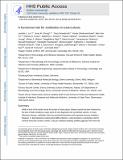A Functional Role for Antibodies in Tuberculosis
Author(s)
Lu, Lenette L.; Chung, Amy W.; Rosebrock, Tracy R.; Ghebremichael, Musie; Grace, Patricia S.; Schoen, Matthew K.; Tafesse, Fikadu; Martin, Constance; Leung, Vivian; Mahan, Alison E.; Sips, Magdalena; Kumar, Manu P.; Tedesco, Jacquelynne; Robinson, Hannah; Tkachenko, Elizabeth; Draghi, Monia; Freedberg, Katherine J.; Streeck, Hendrik; Suscovich, Todd J.; Restrepo, Blanca I.; Day, Cheryl; Fortune, Sarah M.; Alter, Galit; Yu, Wen-Han; Lauffenburger, Douglas A; ... Show more Show less
Downloadnihms864961.pdf (1.215Mb)
PUBLISHER_CC
Publisher with Creative Commons License
Creative Commons Attribution
Terms of use
Metadata
Show full item recordAbstract
While a third of the world carries the burden of tuberculosis, disease control has been hindered by a lack of tools, including a rapid, point-of-care diagnostic and a protective vaccine. In many infectious diseases, antibodies (Abs) are powerful biomarkers and important immune mediators. However, in Mycobacterium tuberculosis (Mtb) infection, a discriminatory or protective role for humoral immunity remains unclear. Using an unbiased antibody profiling approach, we show that individuals with latent tuberculosis infection (Ltb) and active tuberculosis disease (Atb) have distinct Mtb-specific humoral responses, such that Ltb infection is associated with unique Ab Fc functional profiles, selective binding to FcγRIII, and distinct Ab glycosylation patterns. Moreover, compared to Abs from Atb, Abs from Ltb drove enhanced phagolysosomal maturation, inflammasome activation, and, most importantly, macrophage killing of intracellular Mtb. Combined, these data point to a potential role for Fc-mediated Ab effector functions, tuned via differential glycosylation, in Mtb control.
Date issued
2016-09Department
Massachusetts Institute of Technology. Department of Biological EngineeringJournal
Cell
Publisher
Elsevier
Citation
Lu, Lenette L. et al. “A Functional Role for Antibodies in Tuberculosis.” Cell 167, 2 (October 2016): 433–443 © 2016 Elsevier Inc
Version: Final published version
ISSN
0092-8674
1097-4172